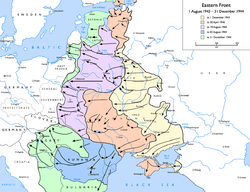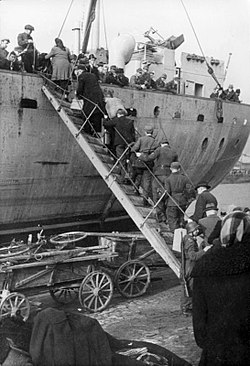| Battles of the Courland Bridgehead | |||||||
|---|---|---|---|---|---|---|---|
| Part of the Eastern Front (World War II) | |||||||
| |||||||
| Belligerents | |||||||
|
|
| ||||||
| Commanders and leaders | |||||||
| Carl Hilpert | Ivan Bagramyan | ||||||
| Units involved | |||||||
| Army Group Courland | 1st Baltic Front | ||||||
| Casualties and losses | |||||||
|
Over 150,000 killed and wounded 180,000 captured[1] | 160,948 killed,sick and wounded (16 Feb. to 8 May 1945)[2] | ||||||

Soviet advances on the Eastern Front, 1 September 1943-31 December 1944

Evacuation at Ventspils (Windau), 19 October 1944
The Courland Pocket (German: Kurland-Kessel)[3] referred to the Red Army's blockade or encirclement of Axis forces on the Courland Peninsula during the closing months of World War II. The Soviet commander was General Bagramyan (later Marshal Bagramyan).[citation needed]
The pocket was created during the Red Army's Baltic Strategic Offensive Operation, when forces of the 1st Baltic Front reached the Baltic Sea near Memel during its lesser Memel Offensive Operation phases. This action isolated the German Army Group North (German: Heeresgruppe Nord) from the rest of the German forces between Tukums and Liepāja in Latvia. Renamed Army Group Courland (German: Heeresgruppe Kurland) on 25 January, the Army Group remained isolated until the end of the war. When they were ordered to surrender to the Soviet command on 8 May, they were in "blackout" and did not get the official order before 10 May, two days after the capitulation of Germany. It was one of the last German groups to surrender in Europe.
Background[]
Courland, along with the rest of the Baltic eastern coast and islands, was overrun by Army Group North during 1941. Army Group North spent most of the next two years attempting to take Leningrad, without success. In January 1944, the Soviet Army lifted the siege of Leningrad.
On 22 June 1944, the Red Army launched the Belorussian Strategic Offensive, codenamed Operation Bagration. The goal of this offensive was to liberate the Belorussian SSR from the German occupation. Operation Bagration was extremely successful, resulting in the almost complete destruction of Army Group Centre, and ended on 29 August. In its final stages (the Kaunas and Šiauliai Offensives), Operation Bagration saw Soviet forces strike deep towards the Baltic coast, severing communications between the German Army Group North and the remnants of Army Group Centre.
After Operation Bagration ended, the Soviets continued the clearing of the Baltic coast, despite German attempts to restore the front (Operation Doppelkopf). The Red Army fought the Memel Offensive Operation with the goal of isolating Army Group North by capturing the city of Memel (Lithuanian language: Klaipėda ).
Battles of the "Courland Bridgehead"[]

Army Group Courland cuff title.
On 9 October 1944, the Soviets reached the Baltic Sea near Memel after over-running headquarters of the 3rd Panzer Army. As a result, Army Group North was cut off from a route to East Prussia. Hitler's military advisors—notably Heinz Guderian, the Chief of the German General Staff—urged evacuation and utilisation of the troops to stabilise the front in central Europe. However, Hitler refused, and ordered the German forces in Courland and the (Estonian) islands Hiiumaa and Saaremaa to hold out, believing them necessary to protect German submarine bases along the Baltic coast. Hitler still believed the war could be won, and hoped that Dönitz's new Type XXI U-boat technology could bring victory to Germany in the Battle of the Atlantic, forcing the Allies out of Western Europe. This would allow German forces to focus on the Eastern Front, using the Courland Pocket as a springboard for a new offensive.[4]

Stamp used in Courland pocket (1945)
Hitler's refusal to evacuate the Army Group resulted in the entrenchment of more than 200,000 German troops largely of the 16th Army and 18th Army, in what was to become known to the Germans as the "Courland Bridgehead". Thirty-three divisions of the Army Group North—commanded by Ferdinand Schörner—were cut off from Prussia and spread out along a front reaching from Riga to Liepāja, retreating to the more defensible Courland position, abandoning Riga.[5]
The German two-phase withdrawals during the execution of the second stage of the Soviet Baltic Offensive (14 September-24 November 1944), subsequent to the pocket being formed in the Baltic Offensive's first stage, the Memel Offensive Operation.
From 15 to 22 October 1944 — Soviets launched the Riga Offensive Operation on the 15th at 10:00 after conducting a heavy artillery barrage.[6] Hitler permitted the Army Group Commander, Ferdinand Schoerner, to commence withdrawal from Riga on 11 October, and the city was taken by the 3rd Baltic Front on 13 October.[7] The front stabilised with the main remnant of Army Group North isolated in the peninsula.
On 15 January 1945, Army Group North was renamed Army Group Courland (Heeresgruppe Kurland) under Colonel-General Dr Lothar Rendulic. In the middle of January Heinz Guderian got Hitler’s permission to withdraw 7 divisions from Courland, however, Hitler refused to consider a total withdrawal.[8][page needed]
On 8 May, Germany's Head of State (Staatsoberhaupt) and President (Reichspräsident) Karl Dönitz ordered Colonel-General Carl Hilpert—the Army Group's last commander—to surrender. Hilpert, his personal staff, and staffs of three Armies surrendered to Marshal Leonid Govorov, the commander of the Leningrad Front. At this time, the group still consisted of the remnants of 27 divisions and one brigade.[9]
On 8 May, General Rauser succeeded in obtaining better surrender terms from the Soviet command.[10] On 9 May, the Soviet commission in Peilei started to interrogate the captive staff of Army Group Courland, and general collection of prisoners begun.[citation needed]
By 12 May, approximately 135,000 German troops surrendered in the Courland Pocket. On 23 May, the Soviet collection of the German troops in the Courland Pocket was completed. A total of about 180,000 German troops were taken into captivity from the Baltic area. The bulk of the prisoners of war were initially held at the Valdai Hills camps.[citation needed]
Order of Battle[]
German[]
See also Army Group Courland
Army Group North (to 25 January 1945)
Army Group Courland (25 January 1945 to 8 May 1945) [11]
German 16th Army[]
German 18th Army[]
| as at 5 November 1944: | as at 19 February 1944: |
|---|---|
| I Army Corps | I Army Corps |
| II Army Corps | |
| X Army Corps | X Army Corps |
| III SS Corps | |
| 52nd Infantry Division, 300th Infantry Division, 563rd Infantry Division | 52nd Infantry Division, 14th Panzer-Division [12] |
Army Group Kurland included the 4th and 12th Panzer Divisions.
The 4th Panzer Division was evacuated from the bridgehead in January 1945.
The Siege[]
The First Courland Battle was intended to destroy German forces. After that failure, official accounts ignore Courland, stating only that the Soviet goal was to prevent the Germans from escaping.[1]
In this account, the Soviet actions in Courland were defensive blockading operations. Hostilities consisted of containing German breakout attempts, and the Red Army made no concerted effort to capture the Courland Pocket,[citation needed] which was of little strategic importance after the isolation of Army Group North, whereas the main offensive effort was required for the Vistula-Oder and Berlin Offensives. Soviet forces suffered correspondingly low casualties. While the modern research of Grigoriy Krivosheev offers a low account of Soviet casualties: 30,501 "irrecoverable" and 130,447 "medical" losses, for a total of 160,948 Soviet casualties between 16 February and 8 May 1945,[2] that period covers only the Fifth and Sixth (and final) Battles of Courland.[citation needed]
According to Russian historian A. Isayev, Courland was a peripheral front for both the Soviets and Germans. The Soviet goal was to prevent the German troops there from being transported by sea to reinforce the defense of Berlin. Soviet operations intended to further isolate and also destroy the enemy, but the strength of the attacking troops was too low to make any significant progress in the difficult terrain. However, the Soviet commanders worked competently and as a result the casualties were low.[13]
Aftermath[]
On 9 May 1945, General Hovhannes Bagramyan accepted the surrender of German forces at Ezere Manor in southwest Latvia.[citation needed]
According to Russian records, 146,000 German and Latvian troops were taken prisoner, including 28 generals and 5,083 high-ranking officers,[6] and taken to camps in the USSR interior and imprisoned for years. Current scholarship puts the count of those surrendering at more than 200,000:[1] 189,112 Germans including 42 generals—among them the German commander, Carl Hilpert, who subsequently died in a Soviet POW camp in 1947[1]—and approximately 14,000 Latvians.[14]
The Soviets detained all males between the ages of 16 and 60, and conducted widespread deforestation campaigns, burning vast tracts of forest, to flush out resisters.[6]
Footnotes[]
- ↑ 1.0 1.1 1.2 1.3 Grier, Howard D. (2007). Hitler, Dönitz, and the Baltic Sea: The Third Reich's Last Hope, 1944-1945. Annapolis: Naval Institute Press. pp. 81–88. ISBN 978-1-59-114-345-1.
- ↑ 2.0 2.1 Krivosheyev, Grigoriy F., ed (2001) (in Russian). Россия и СССР в войнах XX века: Потери вооруженных сил. Статистическое исследование [Russia and the USSR in the Wars of the Twentieth Century: Losses of the Armed Forces. A Statistical Study]. Moscow: OLMA-Press. ISBN 5-224-01515-4.
- ↑ Russian: блокада Курляндской группировки войск (Blockade of the Courland army group), German: Kurland-Brückenkopf (Courland Bridgehead), Latvian language: Kurzemes katls (Courland Cauldron) or Kurzemes cietoksnis (Courland Fortress).
- ↑ Weinberg, Gerhard L. (1995). Germany, Hitler, and World War II: Essays in Modern German and World History. Cambridge: Cambridge University Press. p. 290. ISBN 0-521-56626-6.
- ↑ McAteer, Sean (2009). 500 Days: The War in Eastern Europe, 1944-1945. Pittsburgh: Dorrance Publishing Co. ISBN 978-1-4349-6159-4. http://books.google.com/books?id=Bg8drRyDGhEC&dq=McAteer,+Sean.+500+Days:+The+War+in+Eastern+Europe,+1944-1945&printsec=frontcover&source=bl&ots=9qbO1BIzOL&sig=DY6T0ZHHm3E4wLtqY2R8EEiQydw&hl=da&ei=67gsS9eiOIjj-Qa1jLGEBg&sa=X&oi=book_result&ct=result&resnum=6&ved=0CCMQ6AEwBQ#v=onepage&q=&f=false.
- ↑ 6.0 6.1 6.2 Švābe, Arveds, ed (1950-55) (in Latvian). Latvju Enciklopēdija. Stockholm: Trīs zvaigznes. p. 3. OCLC 11845651.
- ↑ Mitcham, Samuel (2007). German Defeat in the East. Mechanicsburg: Stackpole. p. 152. ISBN 0-8117-3371-8.
- ↑ Mangulis, V. Latvia in the Wars of the 20th Century. CHAPTER IX JULY 1941 TO MAY 8, 1945. Historia.lv.
- ↑ Kozlov, M. M., ed (1985) (in Russian). Velikaya Otechestvennaya Voina 1941-1945: Entsiklopediya [The Great Patriotic War, 1941-1945: An Encyclopaedia]. Moscow: Soviet Encyclopedia. p. 442.
- ↑ Thorwald, Jürgen (1951). Wieck, Fred. ed. Flight in the Winter: Russia Conquers, January to May 1945. New York: Pantheon. p. 64.
- ↑ ordersofbattle.com article
- ↑ lexicon-der-wehrmacht
- ↑ Isayev, Aleksey (December 28, 2009) (in Russian). Unknown Winter of 1945. Interview with Dmitriy Zakharov. Price of Victory. Echo of Moscow. Moscow. http://echo.msk.ru/programs/victory/644363-echo. Retrieved August 13, 2012.
- ↑ Haupt, Werner (2009) (in German). Heeresgruppe Nord: Der Kampf im Nordabschnitt der Ostfront 1941-1945. Dörfler Verlag GmbH. ISBN 978-3895555909.
Sources[]
- Dallas, Gregor., 1945: The War That Never Ended, Yale University Press, Yale, 2006 ISBN 0-300-10980-6
The original article can be found at Courland Pocket and the edit history here.